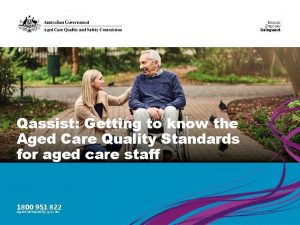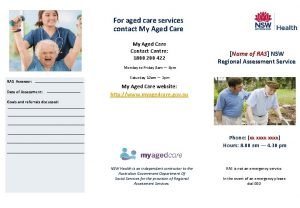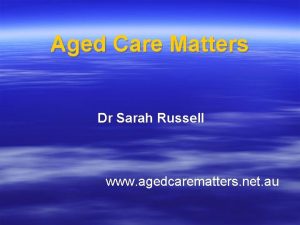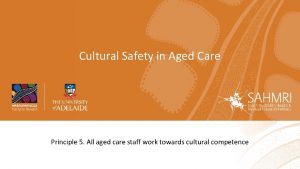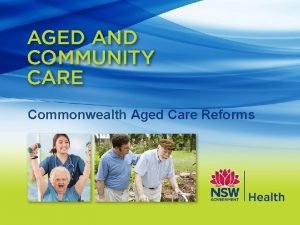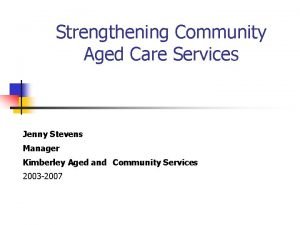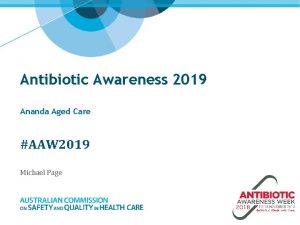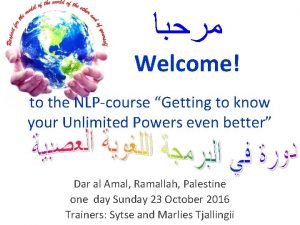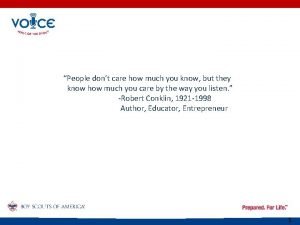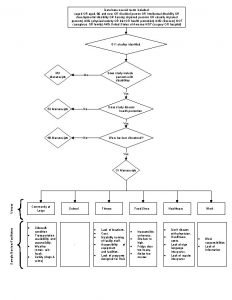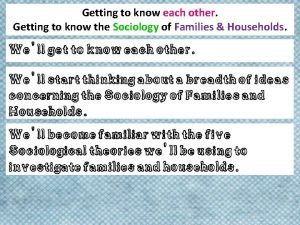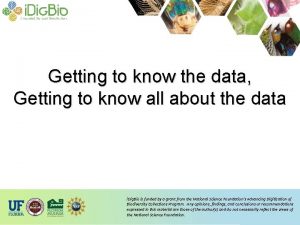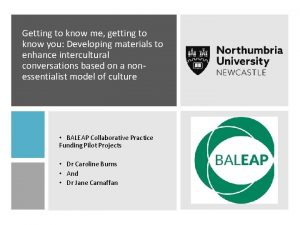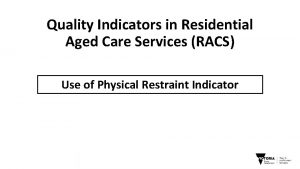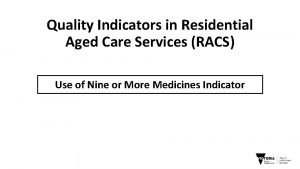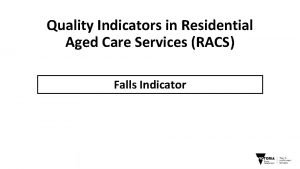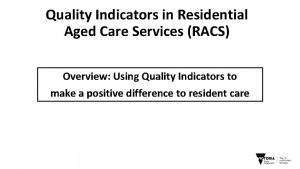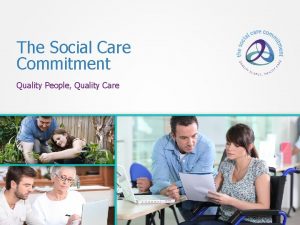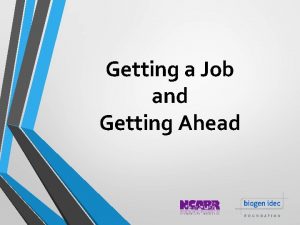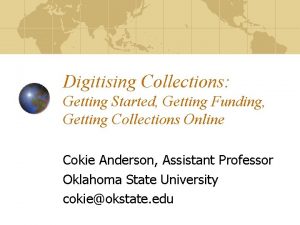Qassist Getting to know the Aged Care Quality

























- Slides: 25

Qassist: Getting to know the Aged Care Quality Standards for aged care staff 1800 951 822 agedcarequality. gov. au

Learning outcomes � • Describe the new Aged Care Quality Standards and what they mean. • Build a shared understanding about your role in demonstrating performance against the requirements.

�hy do we have a new set of W Aged Care Quality Standards? � What does this mean for our organisation? �

Exploring what is new and what it means for us � • The new Aged Care Quality Standards have a stronger focus on quality outcomes for consumers. • There is one set of Standards for all aged care services. • Aged care services will be assessed against all or a subset of the eight standards depending on the type of services they provide. • We will be having new and different conversations in our workplace.

�he NEW T Aged Care � Quality � Standards �

Each of the Standards is expressed in three ways � Consumer outcome Organisation statement Requirements

�et to G know the � Standards �

Standard 1 – Consumer dignity and choice � Foundation Standard with six requirements � Standard 1 contains seven important concepts: � • Dignity and respect • Identity, culture and diversity • Cultural safety • Choice • Dignity of risk • Information • Personal privacy

Standard 1 – Consumer dignity and choice � I�am treated with dignity and respect, and can maintain my identity. I can make informed choices about my care and services, and live the life I � choose. • What does this look, sound and feel like in our organisation? • What does this mean to me in my role? • What might need to change to meet this Standard? • What will the changes mean for me in my role? • What are the risks if we don’t change?

Standard 1 – Consumer dignity and choice � If you were asked, can you talk about how you: � • Treat consumers with dignity and respect and what this looks like. • Know about consumers diversity and what this means for the way you do your work. • Help others to do the right thing, if you see something that is not respecting consumers for who they are, what they believe or how they choose to live their lives. • Help consumers to make day-to-day choices so they have control over their lives, this includes taking risks. • Get information that is up to date and accurate and easy to understand for consumers. • Support consumers privacy.

�tandard 2 – Ongoing assessment and care planning S with consumers I�am a partner in ongoing assessment and planning that helps me get the care and services I need for my health and well-being. � • What does this look, sound and feel like in our organisation? • What does this mean to me in my role? • What might need to change to meet this Standard? • What will the changes mean for me in my role? • What are the risks if we don’t change?

�tandard 2 – Ongoing assessment and care S planning with consumers � If you were asked, can you talk about how you: � • Are involved in working with consumers to identify their needs, choices and preferences. • Work with consumers to provide care and services that meets their needs, choices and preferences. • Work with consumers to makes changes to the way you provide care and services. • Act on and report issues if there is an incident or risk with the way care and services are provided. • Support all aspects of a consumers health and well-being including taking risks.

Standard 3 – Personal and clinical care � I get personal care, clinical care or both personal and clinical care, � that is safe and right for me. � • What does this look, sound and feel like in our organisation? • What does this mean to me in my role? • What might need to change to meet this Standard? • What will the changes mean for me in my role? • What are the risks if we don’t change?

Standard 3 – Personal and clinical care � If you were asked, can you talk about how you: � • Provide personal and clinical care within your scope of practice that is focused on the consumers needs, goals and preferences. • Find out about the best ways to provide personal and clinical care. • Know if a consumer has personal or clinical care needs that might need extra care or precautions to support them. • Support the wishes of consumers that are nearing their end-of-life. • Act on and report any incidents or risks with the way care and services are provided.

Standard 4 – Services and supports for daily living � I get the services and supports for daily living that are important for my health � and well-being and that enable me to do the things I want to do. � • What does this look, sound and feel like in our organisation? • What does this mean to me in my role? • What might need to change to meet this Standard? • What will the changes mean for me in my role? • What are the risks if we don’t change?

Standard 4 – Services and supports for daily living � If you were asked, can you talk about how you: � • Support consumers to do as much as they can for themselves. • Support the whole person’s well-being (emotional, psychological and spiritual). • Know about and support the cultural needs and preferences of consumers. • Help consumers to do the things that interest them, have social and personal relationships and be part of the community. • Report and act upon something a consumer tells you they want or need that you might not be able to do. • Support consumers to eat and drink what they want and need to maintain their health and well-being. • Use and operate equipment safely and identify risks.

Standard 5 – Organisation’s service environment � I feel I belong and I am safe and comfortable in the organisation’s service � environment. • What does this look, sound and feel like in our organisation? • What does this mean to me in my role? • What might need to change to meet this Standard? • What will the changes mean for me in my role? • What are the risks if we don’t change?

Standard 5 – Organisation’s service environment � If you were asked, can you talk about how you: � • Contribute to the service being welcoming to all consumers. • Support consumers to be independent and to get around the inside and outside areas, including those with limited mobility. • Know the environment is safe for consumers. • Respond if there is a safety incident, hazard or emergency. • Use equipment safely and report if there is an issue. • Know what equipment is being used to meet consumers needs.

Standard 6 – Feedback and complaints � I feel safe and am encouraged and supported to give feedback and make � complaints. I am engaged in processes to address my feedback and complaints, and � appropriate action is taken. • What does this look, sound and feel like in our organisation? • What does this mean to me in my role? • What might need to change to meet this Standard? • What will the changes mean for me in my role? • What are the risks if we don’t change?

Standard 6 – Feedback and complaints � If you were asked, can you talk about how you: � • Support consumers/families/representatives to provide feedback or make a complaint. • Respond to consumers/families/representatives feedback or complaints. • Know about how the organisation complaints system works. • Would go about getting support for a consumer that may need an advocate or translator. • Know if a complaint is resolved and what you might say to consumers/families/representatives. • Know that things have changed or improved as a result of acting on and resolving a complaint.

Standard 7 - Human Resources � I get quality care and services when I need them from people who are knowledgeable, capable and caring. � • What does this look, sound and feel like in our organisation? • What does this mean to me in my role? • What might need to change to meet this Standard? • What will the changes mean for me in my role? • What are the risks if we don’t change?

Standard 7 – Human resources � If you were asked, can you talk about how you: � • Are kind, caring and respectful and what you might do if you saw someone being disrespectful or unkind to a consumer. • Do your work and ensure it meets the needs, goals and preferences of consumers. • Are provided with training and support to do your work well and within your scope of practice. • Can provide feedback on your training and support needs. • Are provided with feedback about how well you do your job and where you might need to change your practice to meet consumers needs or improved outcomes for consumers.

Standard 8 – Organisational governance � I�am confident the organisation is well run. I can partner in improving the delivery of care and services. � • What does this look, sound and feel like in our organisation? • What does this mean to me in my role? • What might need to change to meet this Standard? • What will the changes mean for me in my role? • What are the risks if we don’t change?

Standard 8 – Organisational governance � If you were asked, can you talk about how you: � • Work with consumers to provide high quality care and services. • Use consumers feedback to improve the way things get done. • Make sure that everyone is respected for who they are. • Seek feedback from both staff and consumers to improve the organisations systems and processes. • Support staff to identify and manage risk. • Ensure consumers are safe from harm, abuse or neglect. • Monitor how care and services are provided. • Respond in an open and transparent way when things go wrong. • Provide staff with training and support.

Learning and reflection � What? � • What have you learned? So what? � • What does thus mean for you and your role? Now what? � • What are you going to do differently or change that will make a difference? “We do not learn from � experience… we learn from reflecting � on experience. ” - John Dewey �
 Qassist
Qassist Qassist
Qassist Open disclosure in aged care
Open disclosure in aged care Sarah russell aged care
Sarah russell aged care 5 principles of cultural safety australia
5 principles of cultural safety australia My aged care
My aged care Dignity of risk example
Dignity of risk example Kimberley aged care services
Kimberley aged care services What is cultural safety in aged care
What is cultural safety in aged care Ananda aged care
Ananda aged care The secret of getting ahead is getting started
The secret of getting ahead is getting started Unit 1 getting to know my classmates
Unit 1 getting to know my classmates Get to know you questions for adults
Get to know you questions for adults A case of murder by vernon scannell
A case of murder by vernon scannell My son aged three fell in the nettlebed
My son aged three fell in the nettlebed Colors in great gatsby
Colors in great gatsby Primary secondary tertiary medical care
Primary secondary tertiary medical care Know history know self
Know history know self Do deep generative models know what they don’t know?
Do deep generative models know what they don’t know? He is a friend of mine the god of angel armies
He is a friend of mine the god of angel armies People don t care how much you know
People don t care how much you know Perform quality assurance
Perform quality assurance Plan quality management pmp
Plan quality management pmp Pmbok quality assurance vs quality control
Pmbok quality assurance vs quality control Quality assurance cycle in nursing
Quality assurance cycle in nursing Quality improvement vs quality assurance
Quality improvement vs quality assurance
